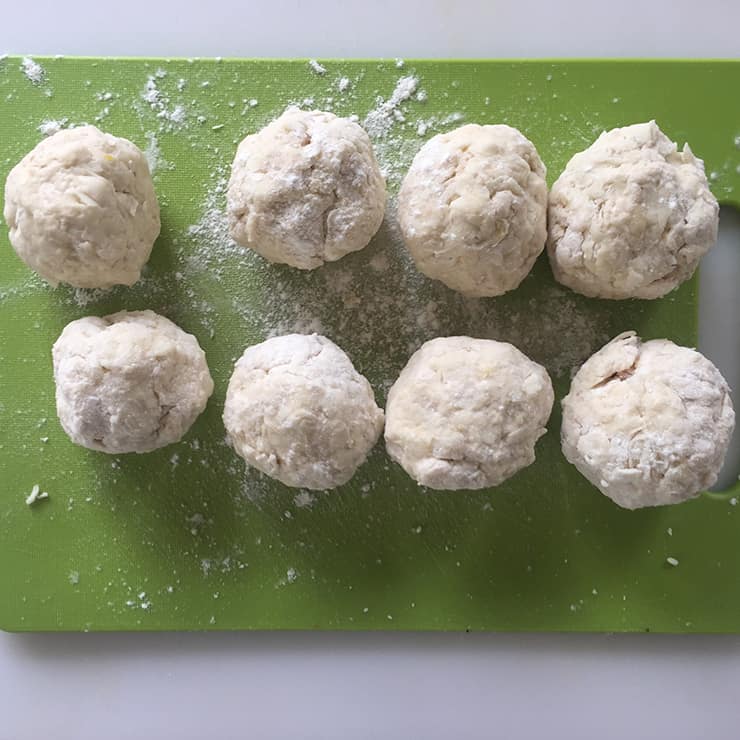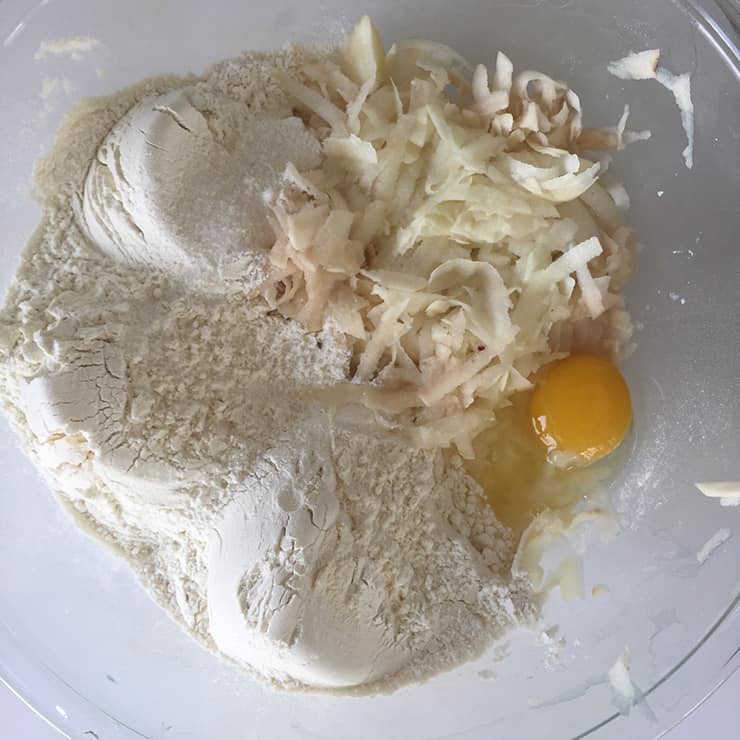This post may contain affiliate links. As an Amazon Associate I earn from qualifying purchases. Please read our disclosure policy.
Scandinavian comfort food that goes by many names. Whether you call it Pault, Pult, Klubb, Klub, Korppkakor, Raspeball, kumle, komle, kompe, or potetball… it is the same delicious flavors. This Klubb Recipe is great. Often served as a Norwegian holiday favorite in our area, these Norwegian Potato Dumplings holds a place in many family traditions.

I sort of fell deep into heritage recipes with our Knoephla Soup series and we are going to explore that a bit more today. We are going to move away from Germany, however, and are going to travel to Norway to make some Klubb. Klubb is a traditional meat-filled Norwegian potato dumpling that really is tasty, filling, and interesting. Join us on our adventure of making Klubb, a Norwegian Potato Dumpling.
What are Klubb Dumplings?
I already established that it is a Norwegian dumpling, but there is more to it than that. The actual dumpling portion is a mix of shredded potatoes and flour. Then, the center of the dumplings have a hunk of salted pork. Other kinds of meat work, but pork is the most common. I tried several different variations and I think ham works quite well.
These are fairly dense and filling dumplings that are fairly large. I would say that I had the best results with making them about the size of extra large meatballs or maybe slightly smaller than the size of a racquetball. They are tasty little suckers.
Other Names and Locations
While I know this dish as a Norwegian one, it has roots in many parts of Scandinavia and is known by many names. Pault, Pult, Klubb, Klub, Korppkakor, Raspeball, kumle, komle, kompe, and potetball are all names that I have heard for this same recipe. A friend told me about pault and that it is from Swedish origin, but is the same dish. I think it is fair to say that it really is a Scandinavian dish.
Making Klubb Dumplings
It actually took me quite a few times to get these little suckers right. At first, I was finding that the recipe I was making was more of a batter and they would pork-filledfall apart in the simmering water. I also experimented with different sizes of shreds and I found similar frustration. Finally, I figured it out.
This dumpling dough should have a consistency that is similar to a dense bread or pizza dough before it has risen. It should feel and look solid enough so that it might weather 30-45 minutes in simmering water. I found that if I started off with my shredded potatoes and eggs, I could add flour until I created a manageable dough. I mixed it until it was kneadable like a bread dough and firm. For me, the ratio I found was about 4 potatoes and 3 cups of flour, but I would not hesitate to add more flour if need be.
Simmering These Dumplings
There are a few things to watch for when making Klubb dumplings, particularly when simmering these dumplings. First, use a large pot. We do not want to crowd these guys. They need room. Second, use plenty of salt in the water you are making these dumplings in. This will give these guys a bit more flavor.
Finally, be aware of stirring these dumplings. There is a bit of a balance going on when you are simmering these dumplings. I found that they have a tendency to stick to the bottom of the pan, which you want to prevent. At the same time, you do not want to agitate the dumplings so much that they start to fall apart in the pot.
To combat them falling apart, I add them to the pot and allow to simmer for five minutes. Then, using a large metal spoon or spatula, I make sure the dumpling are not sticking to the bottom and carefully loosening them if they are. We want to work to make sure the dumplings stay in tact and are not sticking at the bottom. After the first 10 minutes, you are probably in a safer zone, but just something to watch for.
Serve with Butter
The accompaniments of this dish are super simple. A few chopped green onions, melted butter, salt, and pepper are all that is needed for this dish. It really is a filling meal and does not need much more than the dumplings themselves.
Leftovers RULE
I told my father-in-law I was making this and he told us about a fond memory of his. His mother used to make this dish, but then these dumplings were served for breakfast the next day as leftovers. They would chop up the dumplings, fry them in butter, and then serve them with syrup. We tried it and it really is great. I think I found something to experiment with.
While he recommended syrup, in my mind I was thinking that this really could be good with some Asian spice flavors as well. Sriracha or Sambal Oelek could work really well with these leftovers. So much food to eat and not enough belt notches to expand to. Sigh.




I hope you really enjoyed our little departure from Knoephle soup and feel like making this dumpling. Thank you so much for reading along and if you like what we are doing, please take some time to subscribe to my email, follow me on Instagram, and follow me on Pinterest.
Products Used In This Recipe
Print
Klubb Recipe – Norwegian Potato Dumplings
- Prep Time: 15 minutes
- Cook Time: 45 minutes
- Total Time: 1 hour
- Yield: 8-12 dumplings 1x
- Category: Dumplings
- Method: Simmer
- Cuisine: Norwegian
Description
These Norwegian Klubb Dumplings are so tasty, filling, and a great way to celebrate Scandinavia. Whether it is a holiday tradition or a weeknight meal, these dumplings are worth the effort.
Ingredients
- 4 potatoes, peeled and shredded
- 3 cups flour
- 1 teaspoon salt
- 1 egg
- Approximately 4 ounces ham or other cooked pork cut into 8–12 cubes
- 5 Tablespoons melted butter
- Salt and pepper to taste
Instructions
- Bring large pot of salted water to hard simmer
- While water is warming, grate potatoes and put in big bowl
- Add flour, egg, and salt to the bowl
- Mix and knead until firm. Add more flour if necessary to bring to stiff bread dough consistency
- Wrap dough around one cube of ham. Each dumpling should be the size of a large meatball and you should get 8-12 dumplings.
- Drop dumpling into simmering water and allow to cook for 45 minutes, making sure dumpling does not stick to the bottom of the pot.
- remove with a slotted spoon and serve with butter, salt, and pepper












I think simmering them in some chicken broth would taste great
I am of Norwegian heritage and it was a winter treat when I. Was growing up we new them as potatoe balls and would have them a couple times a winter. When my mother made them she salted spare ribs a few hours before and the boiled the ribs, with, carrots and turnips then took the ribs and veggies out and would put the formed potatoe ball with salt pork in the centre and simmer till cooked
Thank you so much for sharing and it sounds like you have some great memories surrounding these! Have a great Christmas!
This is a recipe that is traditionally passed down in our family. We make it 2 to 3 times a year for the extended family reunions. (20+ lbs of potatoes/ 10+ lbs of flour) I would recommend a meat grinder for the potatoes, instead of shredding them, also squeeze some of the juice out of the Potato, before you mix in the flour. Keeps them from getting to heavy. My grandma always said, “mix it till it sounds like a baby’s butt when you spank it” So, it gets to a certain point, we start spanking the mixture. Listening for the right “tone” so that we know it’s ready. We will be making a big batch tomorrow!
Thanks for sharing your story and recipe!
My mother would use a corned beef to flavor the cooking water, and drop the kumle, as we call it, into the simmering water, cooking both at the same time. And by the way, she always “wrung’ out the shredded potatoes in a cloth to get the excess moisture out. The corned beef was then used as side meat for the balls. And yes, next day, they were sliced and fried in butter. Yum!
Sounds great. Thanks for sharing your story.
I wonder, can these dumplings be steamed in a covered dish in the oven or perhaps a steamer basket over boiling water, or do they need the moisture of the boiling water to cook through to the right consistency and doneness?
I would hesitate on that. Because of the size and density, I think they might need the boiling water.
My family recipe, passed down from my Norwegian side is much simpler. I make it just like Grandma did.
I love to make this Christmas day, because most of the day there’s no work, just a lovely smell in the kitchen, then a little work before dinner, and then comfort and warmth and yumm. I make lefse the day before to serve with it, and Grandpa always wanted green beans as the side, but occasionally we mix it up and serve a different veggie.
First I boil a ham shank all day in my biggest stock pot. I get the biggest shank I can find, usually 15-18#. That feeds 12 of us with plenty of leftovers. a pound per person is just about right though, shanks are bony so a lot of the weight is bones and fat.
We peel and shred russet potatoes. I do 5-10lbs, because I LOVE leftovers, but only shred what you can immediately mix, because otherwise your Klubb will be grey. I like to quarter them or the shreds are too long, and the klubb is just… not right. My grandma used a box grater, I use my food processor with the standard large hole grating disc.
Immediately, we mix in the flour. You keep adding flour until you can’t anymore. The amount of flour varies, so you have to just feel. If they’re still very sticky, you have not added enough. When you just can’t incorporate that last 1/4 cup, you’re ready. If you’ve gone too far and they won’t stick together, add a couple of tbs water. Then you roll them into balls. Grandma made hilariously big klubb balls, they were slow pitch softball sized. HUGE. I prefer smaller, my sister and I use a standard muffin batter scoop, ice-cream scoop, and try to keep them all the same size so they cook well. There is no meat inside ours. Perhaps because of how meaty the rest of the meal is, it doesn’t matter. It means they’re really easy to roll and they don’t tend to fall apart cooking. My sister prefers about 1tbsp baking powder for each 5# of potatoes, I like them either way. Our tradition is just flour and potatoes, but the baking powder does lighten them a little bit.
I then remove the now cooked ham from the broth (boiled ham is the best ham I’ve ever had). I tend the ham with foil and put it in the warming oven to wait for the klubb.
This is where Grandma and I diverge. Grandma would skim off the fat at this point from the ham broth. I do not.
I cook the klubb balls for 20 minutes in boiling ham broth, I cut one in half, if not quite done, I check every 5 or 10 minutes. They are really not too fussy, so overcooking isn’t a big deal. Do make sure after they start cooking to sweep a spoon around the bottom and make sure nobody is stuck and burning on the bottom of the pan.
Grandma served the klubb with ham fat on top, I really really do not like that, so I actually use the broth the klubb cooked in, it’s satly and tasty, but not so heavy. The flour from the balls just makes it that much better. We serve with the lefse, the boiled ham, and usually green beans, and nobody really wants any other sides.
My Grandpa and Dad loved leftovers sliced and fried on a griddle in butter, then eaten with maple syrup. I prefer broth, ham and Klubb. My friend who grew up in a different Norwegian family calls the same thing Kumla, and said her Mom served it for breakfast the next day with warm milk and brown sugar.
Leftovers freeze very well, I freeze one portion with ham, klubb, and broth, and enjoy breaking one out every now and then.
I am tempted to try your version, but I don’t know if I can make myself make klubb any differently. We all just love it the way we have always had it.
Thanks for sharing your recipe! That is awesome!
Enjoyed reading this and plan on trying. Made me think of these https://www.allrecipes.com/recipe/7032/chinese-steamed-buns-with-bbq-pork-filling/ Similar but different and tasty. It’s been a while since I have made them and now I can’t decide which to do first. Thank you for your recipe
P.S. To my above reply. I forgot to mention my heritage is 1/2 Swedish-Finn and I remember my Grandma making dumplings in a milk sauce.
Thanks for the comment! Let me know how it goes for you!
Remember my MIL making Klub with milk sauce too. So good, but I’ve never tried it myself. & now I very seldom Cook. Your recipe is closer to what she used to do. She used side pork when she made her. Basically bacon, but not cured.
Thanks for giving it a look, Gerry.
I can remember the grandmas and mom making klub, they used to use fresh lard, ground potatoes (50lbs), flour, no meat, that I can remember. Mom and her mom worked on the potato mixture and the other grandma would sew up multiple bags from a new white sheet, when the mixture was right it was put in the bags and sewn closed by hand then put in the boiling water in the canning pot, when done we would slice and eat with melted butter. We would feed on this for weeks slicing and frying or adding to meat dishes
Sounds wonderful, Scott! Thanks for sharing your memory. This dish is partially about the traditions and memories of many of our families.
We are German and make basically the same recipe. Our church makes and sells over 1000 at our local Potato Day’s Festival every August in Barnesville MN. They are a treat no matter what your heritage is!
They are a treat! Thanks for looking!